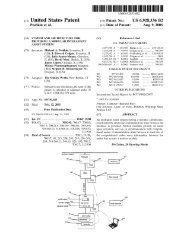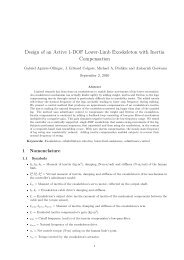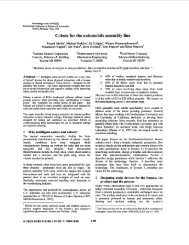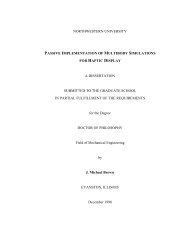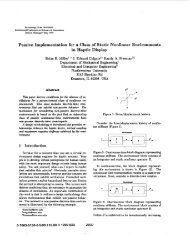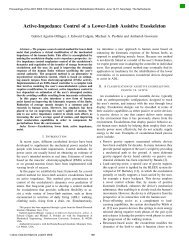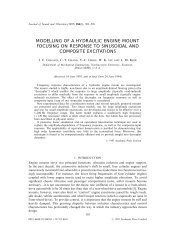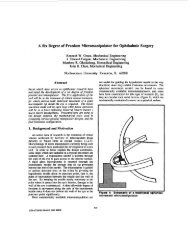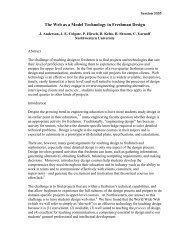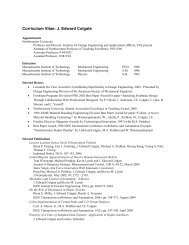Application characteristics of permanent magnet ... - Colgate
Application characteristics of permanent magnet ... - Colgate
Application characteristics of permanent magnet ... - Colgate
You also want an ePaper? Increase the reach of your titles
YUMPU automatically turns print PDFs into web optimized ePapers that Google loves.
992 IEEE TRANSACTIOb IS ON INDUSTRY APPLICATIONS, VOL. 21, NO. 5, SEPTEMBERIOCTOBER 1991<br />
Cogging and Ripple Torques<br />
Cogging and ripple torques are unwanted pulsating torques<br />
that are produced by essentially different phenomena. In a<br />
<strong>permanent</strong>-<strong>magnet</strong> machine, the teeth in the stator can produce<br />
a reluctance torque variation as the rotor rotates. This<br />
reluctance torque that depends on the rotor position and<br />
exists in the absence <strong>of</strong> any armature current is cogging<br />
torque. Hence, cogging is space dependent. Ripple torque is<br />
a consequence <strong>of</strong> armature current commutation and harmonics<br />
that do not produce constant torque. Hence, ripple torque<br />
is essentially independent <strong>of</strong> cogging, and either can exist in<br />
the absence <strong>of</strong> the other.<br />
A design criterion for the minimization <strong>of</strong> cogging torque<br />
has been established [13]. If the reluctance as seen from the<br />
rotor is constant, then cogging torque would be negligible. It<br />
is well known [13] that skewing <strong>of</strong> the stator slots or rotor<br />
<strong>magnet</strong> by one slot pitch reduces cogging to 1-2% (peak to<br />
average) <strong>of</strong> the rated torque [5]. Hence, there is no significant<br />
difference between the cogging torque <strong>of</strong> the PMSM and<br />
the BDCM.<br />
The phase current waveforms <strong>of</strong> the PMSM and the BDCM<br />
are intrinsically different, as was discussed previously. A<br />
sinusoidal current is needed for the PMSM, whereas a rectangular<br />
current is needed for the BDCM to produce constant<br />
torque. Although it is possible to source a sinusoidal current<br />
into the PMSM, it is impossible to source a rectangular<br />
current into the BDCM because the inductance <strong>of</strong> the BDCM<br />
resists rapid current transitions. Therefore, the input current<br />
into the BDCM is trapezoidal rather than rectangular due to<br />
the finite rise time. In addition, a finite time is needed for the<br />
actual current to reach zero from its maximum value in the<br />
BDCM. This forces the actual current to have a trapezoidal<br />
shape rather than the desired rectangular shape needed for<br />
constant torque. It is this deviation that causes the BDCM to<br />
exhibit commutation torque ripples that are absent in the<br />
PMSM drive. At high speeds, these ripples would be filtered<br />
out by the rotor inertia, but at low speeds, they can affect the<br />
performance <strong>of</strong> the drive severely. In particular, the accuracy<br />
and repeatability <strong>of</strong> position servo performance would deteriorate.<br />
It should be noted that in addition to the current<br />
deviating from the desired rectangular shape, the actual<br />
current oscillates around the reference value at a high frequency,<br />
depending on the size <strong>of</strong> the hysteresis bands in a<br />
hysteresis current controller or the switching frequency <strong>of</strong> a<br />
ramp comparison controller. The net effect <strong>of</strong> this highfrequency<br />
current oscillation is to produce a high-frequency<br />
oscillation in the torque, the magnitude <strong>of</strong> which would be<br />
lower than that produced by the commutation <strong>of</strong> the current.<br />
This high-frequency torque oscillation is also present in the<br />
PMSM since a hysteresis or ramp comparison current controller<br />
is also needed here to maintain the current flowing into<br />
the motor as close to sinusoids as possible. In practice, these<br />
torque oscillations are small and <strong>of</strong> sufficiently high frequency<br />
that they are easily damped out by the rotor inertia.<br />
Figs. 8 and 9 show the starting torque <strong>of</strong> the PMSM and<br />
BDCM, respectively. Both are subject to the high-frequency<br />
torque pulsations due to the hysteresis or ramp comparison<br />
0<br />
N I '<br />
0<br />
Fig. 8.<br />
Start-up torque <strong>of</strong> a PMSM.<br />
I I I I<br />
%.m d.os d.10 d.16 d.21 d.p 6.31 d.37 0.42<br />
TIME ISECI +10~<br />
Fig. 9. Start-up torque <strong>of</strong> a BDCM.<br />
current controllers. These can be reduced by using smaller<br />
hysteresis windows or a higher PWM switching frequency.<br />
However, the torque pulsations in Fig. 11 due to the commutation<br />
<strong>of</strong> the phase currents are clearly evident and are much<br />
larger than that produced as a result <strong>of</strong> the current controller<br />
action.<br />
This phenomenon has been observed by others [5]. It is<br />
therefore preferable to use the BDCM for lower performance<br />
speed servos and position servos <strong>of</strong> low resolution, whereas<br />
the PMSM should be used for high-performance speed and<br />
position servo applications like robotics. This is a significant<br />
advantage <strong>of</strong> the PMSM over the BDCM.<br />
Choice <strong>of</strong> Feedback Devices<br />
The fact that the PMSM requires sinusoidal currents while<br />
the BDCM requires rectangular currents leads to differences<br />
in the feedback devices necessary for the proper operation <strong>of</strong><br />
these machines. The current conduction pattern in the BDCM<br />
is as follows: Each phase conducts for 120" and then remains<br />
nonconducting for 60". Current transitions occur every electrical<br />
60"; therefore, it is only necessary to detect these<br />
points on the periphery <strong>of</strong> the motor to commutate the<br />
currents. Hence, rotor position detectors are needed only




